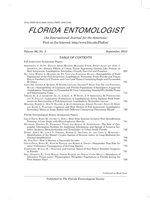Cicadas (Hemiptera: Cicadidae) are important sucking insects, acting as pests of crops. In this study, the occurrence of the cicada, Dorisiana viridis (Olivier), was observed in a macadamia orchard in the Jaboticabal municipality, São Paulo state, Brazil. It is noteworthy that this is the first report of D. viridis infestation on macadamia nut trees.
The macadamia nut tree, Macadamia integrifolia Maiden and Betche (Proteales: Proteaceae), an arboreal species, is cultivated commercially in several regions of the world (Pimentel et al. 2007). In Brazil there are approximately 1.2 million macadamia nut trees, mainly distributed in the Southeast region. Notable among the producing states with high percentage of the national production of this highly prized nut are São Paulo (33%), Espírito Santo (31%), Bahia (18%), and Rio de Janeiro (10%) (Sobierajski et al. 2006; Coplana 2009). In the São Paulo state, this crop has expanded rapidly as an alternative to diversification of agricultural activities. In São Paulo state, there are 587,000 plants cultivated on 2,166 hectares (Barbosa et al. 2003; Squinca et al. 2004).
In agriculture, insect pests represent a phytosanitary problem and may cause significant losses to the producer. Specifically, hemipterans cause direct damage to plants due to their feeding habits. In Brazil, cicadas (Hemiptera: Cicadidae) are recognized as sap-sucking pests of coffee (Coffea sp.; Gentianales: Rubiaceae), causing stunting of the plants and reducing their productivity (Souza et al. 2007). In this country, the cicadas, Quesada gigas (Olivier), Fidicina mannifera (Fabricius) and Dorisiana drewseni (Stal), are associated with 55 plant species, including species important in the fruit, ornamental and forestry industries (Martinelli & Zucchi 1997a; Zanuncio et al. 2004). However, there is no record of these cicada species in macadamia orchards. In Queensland, Australia, cicadas of genus Psaltoda (Hemiptera: Cicadidae) are listed as pests of macadamia (Gallagher et al. 2003).
The present study reports the occurrence of Dorisiana viridis (Olivier) (Hemiptera: Cicadidae) in macadamia nut monoculture orchard, located in the Jaboticabal municipality, São Paulo state, Brazil (S 21° 15′ 22″ W 48°18′58″). The specimens were observed in a commercial orchard of 33 ha, composed of 10 yr-old plants. The association of D. viridis to macadamia trees was determined by the presence of adults, nymphs and exuviae in Nov 2010. Adults were collected by light traps installed inside the orchard, and nymphs were collected by scraping the soil surface encircling the tree trunk with a hoe. Additionally, 60 plants were selected at random and were visually inspected for presence of exuviae on the trunks, and for circular holes on the surface of soil related to the exit of nymphs under the plant canopies. Subsequently, adults, nymphs and exuviae were sent to Dr. Nilza Maria Martinelli, Paulista State University, Jaboticabal campus, who identified the specimens using identification keys based on external morphology and male genitalia (Martinelli & Zucchi 1989; Martinelli & Zucchi 1997b). Following identification, we included the specimens in the Entomological Collection of the Laboratório de Entomologia da Agência Paulista de Tecnologia dos Agronegócios (APTA), Apta Regional Centro Leste, Ribeirão Preto, SP, Brazil.
The adult females of D. viridis collected in the orchard had pale green color, and an average wingspan of 38.0 ±0.14 mm (Fig. 1). In Queensland, Australia, large numbers of adult Psaltoda cicadas emerge in macadamia orchards during the summer; and after mating, the females deposit eggs in slits in the branches. The nymphs feed on the roots, and when they mature they exit the soil and climb onto the tree trunk (Gallagher et al. 2003).
Fig. 1.
Adult female of Dorisiana viridis on a trunk of macadamia nut tree in Jaboticabal, São Paulo State, Brazil.

In the present study, circular output holes of nymphs were observed on the surface of the soil under the canopy of macadamia nut trees (Fig. 2). Further the presence of nymphs were observed under the ground, which indicates that they had fed on macadamia roots, and these plants were observed to have yellowing of leaves, which fell on the soil surface. These symptoms are similar to those observed in macadamia trees affected by cicadas of genus Psaltoda in Queensland, Australia (Gallagher et al. 2003). According to these authors, the branches affected by Psaltoda may splinter and die, and are also more susceptible to wind damage. In Brazil there is information about damage to the coffee crop caused by cicadas. Reis & Souza (1998) observed that the continuous sucking of sap by nymphs causes sap depletion and premature abscission of the apical leaves of coffee plants, resulting in reduced coffee production if the pest is not controlled.
Also we observed immobile D. viridis nymphs on the macadamia tree trunks, and 2,114 exuviae were collected, which represented on an average of 35.2 ±5.31 D. viridis exuviae per sampled plant. Souza et al. (2007) emphasized that a plant species most likely serves as a host for the cicada when there is evidence of nymphs underneath the soil or under its canopy, circular output holes of the nymphs and the presence of exuviae on the trunk.
This is the first record of the occurrence of D. viridis on macadamia nut crop in Brazil, and demonstrates the great potential of damage that this species may cause to this nut tree. There are few studies related to the occurrence of insects in Brazilian macadamia orchards. Only in recent decades has macadamia been cultivated under Brazilian conditions and most of the available information and the technologies for its cultivation have been adapted from research carried out under the climate conditions of Hawaii and Australia. This emphasizes the importance and necessity of acquiring information on the insect fauna of macadamia nut in Brazil; with the aim of developing an integrated pest management program, which depends crucially on the identification of the insect pest species associated with the crop.
ACKNOWLEDGMENTS
We are grateful to the Technical Support Team of “Fazendinha Belo Horizonte”, for his assistance in field activities.






